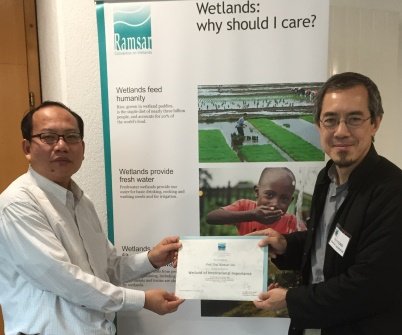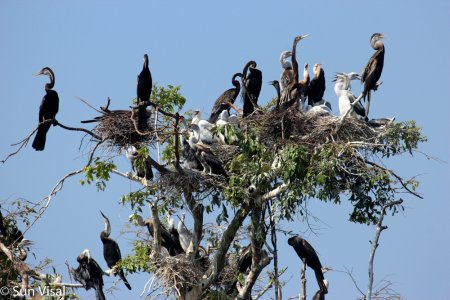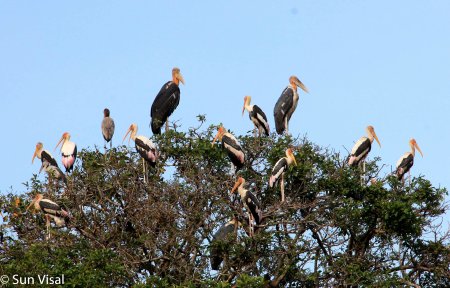Camboya designa las llanuras de inundación de Prek Toal como sitio Ramsar

Camboya ha designado el humedal de Prek Toal como su cuarto sitio Ramsar. El sitio, que abarca más de 21.000 hectáreas, contiene algunas de las llanuras de inundación más prístinas de la Reserva de la Biosfera de Tonle Sap en Camboya. Fuera de la estación lluviosa, el sitio está seco y cubierto principalmente por bosques pantanosos de agua dulce, pero cada año se inunda y la profundidad del agua llega a alcanzar los ocho metros. Prek Toal se encuentra en el extremo noroccidental aguas arriba del lago Tonle Sap y la subida y bajada de las aguas del lago es clave para el mantenimiento de su riqueza biológica.
Los bosques retienen abundantes sedimentos y los nutrientes que se depositan estimulan el crecimiento de plantas y peces, que a su vez alimentan a la gran cantidad de aves acuáticas y otras especies silvestres que existen en el sitio. En Prek Toal existen hábitats para una gran diversidad de especies amenazadas a escala mundial tales como el galápago batagur (Batagur baska), el cocodrilo de Siam (Crocodylus siamensis), el barbo gigante (Catlocarpio siamensis) y el siluro gigante del Mekong (Pangasianodon gigas), que están en peligro crítico. La zona es única en su región biogeográfica por la gran concentración y diversidad de aves acuáticas nidificantes (se cuentan periódicamente más de 20.000 desde 2001), entre las que figuran muchas especies amenazadas a escala mundial tales como el marabú argala (Leptoptilos dubius) y el avesol asiático (Heliopais personatus), que están en peligro.
Las comunidades locales viven en casas flotantes y dependen de la pesca y la acuicultura para su sustento.

“Cambodia should be proud that Prek Toal has been declared as a wetland of international importance. It recognises the years of hard work between government, local communities and NGOs, and opens the door to many more years of this exciting collaboration that has restored Prek Toal to its place as a natural wonder of Cambodia” said Dr. Ross Sinclair, WCS Cambodia Director.
“We congratulate the Royal Government of the Kingdom of Cambodia for putting forward Prek Toal as a new Ramsar Site”, said Dr. Lew Young, Senior Regional Advisor for Asia-Oceania (Ramsar Secretariat), “and we look forward to supporting the Government of Cambodia to designate more Ramsar Sites in future, and to ensure their sustainable management for the benefit of the local people and the environment.”
30% of Cambodia is covered by wetlands and the majority of them have been identified as globally important, owing to the populations of threatened species that they support. In 1999 Cambodia became a Contracting Party to the Ramsar Convention on Wetlands. However, up until now only three Ramsar Sites had been designated. They are:
• Boeng Chhmar and Associated River System and Floodplain (Ramsar Site no. 997);
• Koh Kapik and Associated Islets (Site no. 998), and;
• Middle Stretches of the Mekong River north of Stoeng Treng (Site no. 999).

“Recognizing Prek Toal as a Ramsar Site not only draws attention to the international importance of this wetland but it will be a bridge for Cambodia to nominate more wetlands as Ramsar Sites in the future”, said H.E. Say Samal, Minister of Environment of the Kingdom of Cambodia.
BirdLife International and the Department of Freshwater Wetlands Conservation, Ministry of Environment have been working together towards designating more wetlands as Ramsar Sites in Cambodia since 2008. Prek Toal is the first new Ramsar Site declared in Cambodia in the last sixteen years. “In addition to its biodiversity value, Prek Toal Important Bird Area delivers ecosystem services such as fish which support the livelihoods of the surrounding floating villages, we are delighted at this result” said Mr. Bou Vorsak, BirdLife Cambodia’s Programme Manager. “Ramsar status for this wetland will attract international interest in this fantastic site.”
Each Contracting Party to the Ramsar Convention designates at least one wetland for inclusion in the List of Wetlands of International Importance, and these sites are selected by the Party based on the site’s international significance in terms of ecology, botany, zoology, limnology or hydrology. Worldwide, there are 2,240 Ramsar Sites, making this the largest network of wetland managed for conservation.
Financial support was provided by the Darwin Initiative, a small grant of Japanese Ministry of the Environment, the Keidanren Nature Conservation Fund, a Ramsar Small Grant, and the Wildlife Conservation Society.